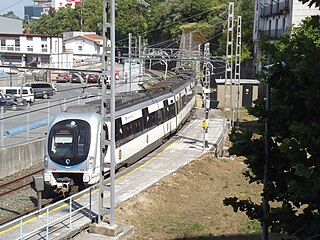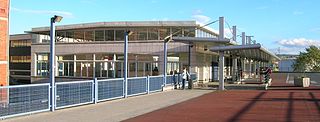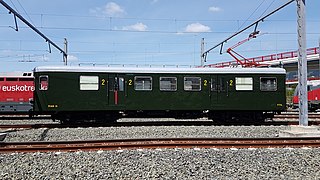
Euskotren Trena, formerly known just as Euskotren is a commuter, inter-city and urban transit train-operating company that operates local and inter-city passenger services in the provinces of Biscay and Gipuzkoa, in the Basque Country, Spain. It is one of the four commercial brands under which Euskotren operates, as a public company managed by the Basque government. The entire 181.1-kilometre (112.5 mi) network uses 1,000 mm narrow gauge rail tracks which have been owned by the Basque Government since their transferral from the Spanish government; the rail tracks and stations were part of the FEVE network until its transferral. Euskotren Trena also operates the Donostia/San Sebastián metro under the brand Metro Donostialdea.

Azpeitia is a town and municipality within the province of Gipuzkoa, in the Basque Country, Spain, located on the Urola river a few kilometres east of Azkoitia. Its population is 14,580. It is located 41 kilometres southwest of Donostia/San Sebastián.
Euskotren, formally known as Basque Railways, is a public railway company controlled by the Basque Government and officially established in 1982 to operate several 1,000 mm narrow gauge railways inside the autonomous community of the Basque Country, under the terms of the Statute of Autonomy of the Basque Country. Originally operating under the commercial brand ET/FV, it took control of the management and operations of the narrow gauge lines formerly operated by the railway company FEVE. The commercial brand eventually changed to Euskotren, as it remains today. Since 2006, the infrastructure on which the company runs its trains has been owned by Euskal Trenbide Sarea.

Leioa is a station on line 1 of the Bilbao metro. It is located in the neighborhood of Udondo, in the municipality of Leioa. The station opened as part of the metro on 11 November 1995, replacing an older station. It is located next to a park and ride facility.

Euskotren operates frequent commuter rail services in the city of San Sebastián and the surrounding Donostialdea area, in the Basque Country, Spain. The infrastructure is gradually being upgraded to rapid transit standards, in order to create the San Sebastián Metro. The line is commonly known as Topo, due to the large number of tunnels present. As of 2021, the San Sebastián suburban rail services are branded as part of the Euskotren Trena network, with no separate identity.

Sondika is a railway station in Sondika, Basque Country, Spain. It is owned by Euskal Trenbide Sarea and operated by Euskotren. It lies on the Txorierri line.

Zarautz is a railway station in Zarautz, Basque Country, Spain. It is owned by Euskal Trenbide Sarea and operated by Euskotren. It lies on the Bilbao-San Sebastián line.
Arroa is a railway station in Zestoa, Basque Country, Spain. It is owned by Euskal Trenbide Sarea and operated by Euskotren. It lies on the Bilbao-San Sebastián line.

Amara is a railway station in San Sebastián, Basque Country, Spain. It is owned by Euskal Trenbide Sarea and operated by Euskotren. It is the eastern terminus of the Bilbao-San Sebastián line and is also served by the suburban Topo service.

Loiola is a railway station in San Sebastián, Basque Country, Spain. It is owned by Euskal Trenbide Sarea and operated by Euskotren. It lies on the San Sebastián-Hendaye railway, popularly known as the Topo line. The Cercanías San Sebastián station of the same name serves the same area, but is unrelated to the Euskotren station.

Pasaia is a railway station in Pasaia, Basque Country, Spain. It is owned by Euskal Trenbide Sarea and operated by Euskotren. It lies on the San Sebastián-Hendaye railway, popularly known as the Topo line. The Cercanías San Sebastián station of the same name is located close to the Euskotren station, but the two are not connected.

Galtzaraborda is a railway station in Errenteria, Basque Country, Spain. It is owned by Euskal Trenbide Sarea and operated by Euskotren. It lies on the San Sebastián-Hendaye railway, popularly known as the Topo line.

Belaskoenea is a railway station in Irun, Basque Country, Spain. It is owned by Euskal Trenbide Sarea and operated by Euskotren. It lies on the San Sebastián-Hendaye railway, popularly known as the Topo line.

Irun Colon is a railway station in Irun, Basque Country, Spain. It is owned by Euskal Trenbide Sarea and operated by Euskotren. It lies on the San Sebastián-Hendaye railway, popularly known as the Topo line.
Euskotren is a public railway operator in the Basque Country, Spain. Its rolling stock is formed by electrical multiple units used for Euskotren Trena commuter rail services, trams running on the Bilbao and Vitoria-Gasteiz tramway networks, and locomotives for hauling freight trains.

The long Ganz railcar is a railcar train type formerly operated by Ferrocarriles Vascongados in the Basque Country, Spain from 1928 to 1981.

The short Ganz railcar is a railcar train type formerly operated by Ferrocarriles Vascongados in the Basque Country, Spain from 1928 to 1981.

The 130T was a steam locomotive type originally operated by Ferrocarriles Vascongados in the Basque Country, Spain. One of the locomotives, named Aurrera, has been preserved at the Basque Railway Museum and is used regularly to haul heritage trains.
Ferrocarriles y Transportes Suburbanos, commonly known by its acronym FTS, was a railway company in the Basque Country, Spain. Founded in 1947 as the merger of various railway companies, it operated several suburban rail lines in the Greater Bilbao area. FEVE took over its operations in 1972, which in 1982 were transferred to the new company Basque Railways.

The Carde y Escoriaza railcar is a railcar train type formerly operated in the Basque Country, Spain. They were introduced in the Bilbao-Plentzia railway in 1927, and were later operated by Ferrocarriles y Transportes Suburbanos, Euskotren, Metro Bilbao and Euskal Trenbide Sarea until 2012.
















